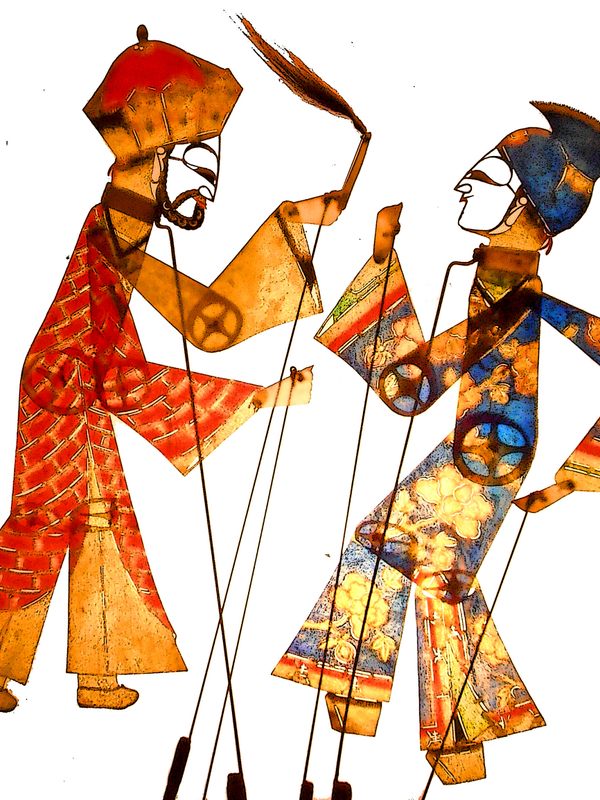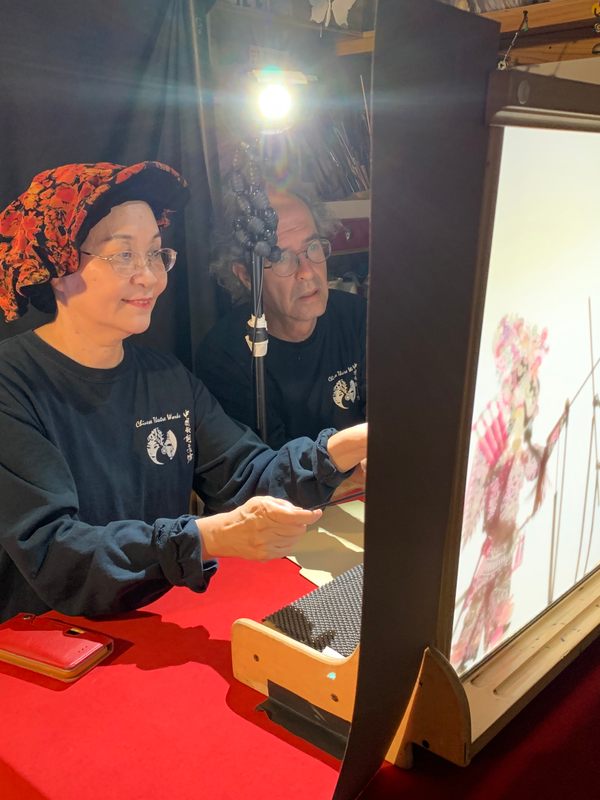



Chinese shadow puppetry is a theatrical art form that dates back thousands of years. The puppets are typically made of semi-transparent leather plates engraved with intricate designs and colored with dyes. When lit from behind, these figures cast colorful shadows onto a screen. Behind the screen, puppeteers move the figures to play out scenes set to music.
In this virtual workshop led by Kuang-Yu Fong & Stephen Kaplin, Co-Artistic Directors of Chinese Theatre Works, you’ll explore the history of Chinese shadow puppetry and see how it has evolved as an art form still practiced today. Along the way, you'll get to see examples of puppets used in theatrical productions. Next, it’s time to get out your scissors and get to work assembling your very own puppet. Kuang-Yu and Stephen will lead guests in a step-by-step process of building a shadow puppet using materials you can find at home! You’ll learn techniques of designing and building shadow figures and how to use shadow theater as a means of visual storytelling.
Supplies Needed
Tools
- Mat knife, sharp scissors, and a metal straightedge
- Needle-nosed pliers
- Staple pliers or regular household stapler
- Large push pin (at least 1)
- Hot glue gun (optional)
Materials for Puppet Figures
- Printed out Tiger figure template found in folder that will be emailed to you (can be printed on regular printer paper, translucent paper or color transparencies) *Please note that these figures are to only be used for the purposes of this workshop and should not be posted on any public platform. Thank you for understanding!
- Cutting board or heavy scrap cardboard work surface
- Craft wire, Wire coat hangers, umbrella spokes, paper clips, or binder clips
- Clear plastic food containers (flat, like a clear plastic takeout salad box), or Lexan, or other thin plastic sheeting(enough to lay out all pieces of the figure, about 8 inches)
- Bamboo skewers, chopsticks or dowels (generally 3 per figure)
- Lace, fringe or woven fabric, scrim or meshy materials, found objects ( These are optional, but good for making scenic elements)
Materials for Your Own Shadow Screen Stage
- Paper & Cardboard: Large Pizza box or other type of cardboard box or Corrugated Cardboard
- Shadow screen material— at least 2’ sq piece. Check translucency with flashlight. Choose one of the following: Heavy white recycling bag, sheet of thin, white plastic (lexan), piece of white fabric (check with a flashlight stretchy knit fabrics are better than woven fabrics for diffusing light), White Tyvek or Parchment paper
- Tape: Clear packing tape (2” wide) and a heavier tape like masking tape, packing, duct or gaffer’s tape. (2” wide)
- Light source: Desk lamp, Small LED lamp fixture and stand, or Cell Phone
- Dowels, Wooden slats, square or corner trim (optional)
ZOOM!
Kuang-Yu Fong majored in Chinese Opera at the Chinese Culture University in Taiwan, where she also taught for four years before coming to New York City in 1983. She received an M.A. in Educational Theater at N.Y.U and became a resident artist upon graduation. She has been a guest professor at the Chinese Opera Academy in Beijing since 1998 and a visiting graduate professor at the University of Maryland in 2008. She was an assistant professor at Pace University till 2012.
Ms. Fong has toured and taught all over the United States and in Asia and Europe. She is the founder of Chinese Theatre Workshop (1995) and Chinese Theatre Works (2001), with whom she conceived, wrote, and directed dozens of original, innovative productions, many of which have been honored with awards, including: “Toy Theater Peony Pavilion,” “Three Women, Many Plays,” “Tiger Tales” and “Songs From the Yellow Earth.”
Ms. Fong has written numerous articles for scholarly journals and for Chinese language magazines. Her first book (co-authored with Stephen Kaplin) is Tabletop Theater: Puppetry for Small Places (2003). She translated Dr. Nellie McCaslin’s book Shows on the Shoestring into Chinese. She has been a panelist for NYSCA, Lower Manhattan Council Foundation and Asian American Arts Alliance She was the first Asian-American to be elected to the board of UNIMA-USA.
Stephen Kaplin has over 30 years of experience designing, building, directing, writing, and performing for live puppet theatre. A graduate of the Puppetry Arts program of the University of Connecticut (1979) and of the NYU’s Performance Studies Department (1989), Mr. Kaplin has forged ongoing relationships with renowned theater directors Julie Taymor (Savages, Liberties Taken, Transposed Heads, The Magic Flute, Fools Fire, Juan Darien , The Green Bird and The Lion King); Lee Breuer (Warrior Ant, Peter and Wendy); George Wolf (Caucasian Chalk Circle, The Tempest, Amistad; Ping Chong (Blindness and Cathay). He has also designed and built puppets and shadow sequences for Alice in Wonderland (Eva La Gallienne, dir), Band in Berlin (Susan Feldman, Pat Birch, dirs), Frida (Hillary Blecher, dir), as well as for the Big Apple Circus; and for “Times Square 2000” (Michael Curry, dir).
Since 1995, Mr. Kaplin has been a collaborator and co-artistic director with Kuang-Yu at the Chinese Theatre Workshop and (since 2001) with Chinese Theatre Works. Together they have produced numerous original theatrical works including Zhang Boils the Ocean; Climbing Gold Mountain; Toy Theatre Peony Pavilion (UNIMA Citation of Excellence, 2001); Kun/Shadow Whitesnake; Tiger Tales; The Birth of Monkey King; Day Jobs/Opera Dream; Songs of the Yellow Earth; Book of Songs, Mulan-Holding Half the Sky. These productions have toured to Taiwan, Korea, Canada, China, and cities across the U.S.
Mr. Kaplin is also a writer and visual artist and a founding member of the performance ensemble Great Small Works.
About Chinese Theatre Works
Chinese Theatre Works is a non-profit organization based in New York City. Their mission is to preserve and promote the traditional Chinese performing arts (including opera, shadow theatre, puppetry, dance and music); to create new works that bridge Eastern and Western aesthetics and forms; and to foster understanding and appreciation of Chinese culture in audiences, students, artists and educators around the globe.
It was founded in 2001 by Co-Artistic Directors Kuang-Yu Fong and Stephen Kaplin, out of the merger of two non-profit institutions with long histories of bringing traditional and contemporary innovative Chinese performing arts programming to New York City, national and international audiences-- The Gold Mountain Institute for Traditional Shadow Theatre (founded by Jo Humphrey in 1975) and Chinese Theatre Workshop (founded 1995). Chinese Theatre Works carries forth their mission by presenting programming drawn from their combined repertoire of traditional Chinese opera, music, dance and puppetry and by creating and touring new original productions as well. Their work cuts across ethnic and cultural boundaries, and their programs are aimed at sparking interest in Chinese cultural traditions among the wider public and building understanding among educators and artists across the globe.
Access to this online experience is free for Atlas Obscura Members. Unlock more wonder by becoming a member today!
Once registered, you can access the Zoom room for this experience through your confirmation email or Eventbrite account. Atlas Obscura online experiences are recommended for attendees age 13+.
This online experience will be recorded. A temporary link to the recording will be provided in a follow-up email to all ticket holders within 72 hours after the event. Access to this recording will be available for seven days.
We provide closed captioning for all of our online Member Experiences, as well as transcripts upon request. Please reach out to us at membership@atlasobscura.com if you have any questions, requests, or access needs.
This event is one of Atlas Obscura’s Membership Experiences. At Atlas Obscura, our mission has always been to inspire wonder and curiosity about the incredible world we all share. Now, more than ever, there’s a need to stay connected—not only to our sense of wonder, but to each other.
We encourage you to follow and share the hashtag #AOExperiences for more incredible online experiences and courses with Atlas Obscura and our friends. And check out AtlasObscura.com, the definitive guide to the world’s hidden wonders, to keep virtually exploring the world through the website’s atlas of amazing places, unique stories, and videos.





